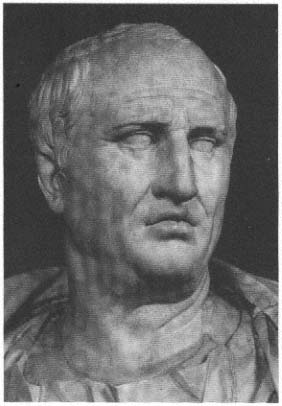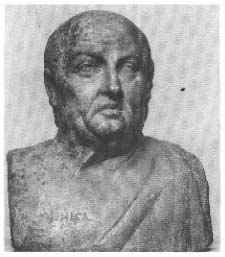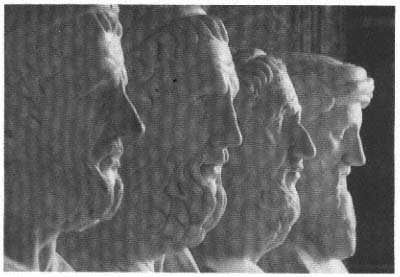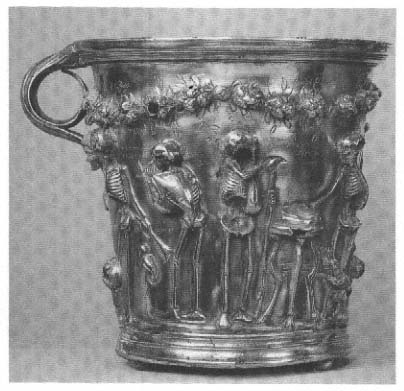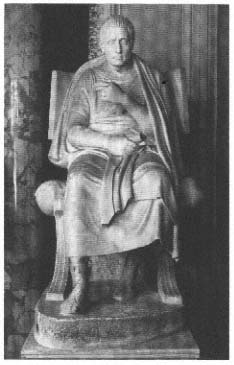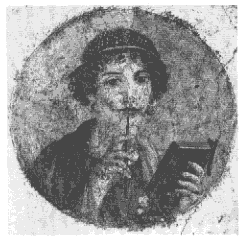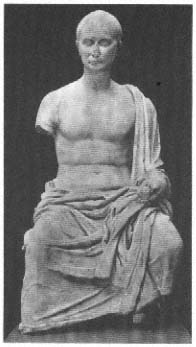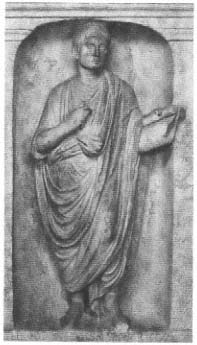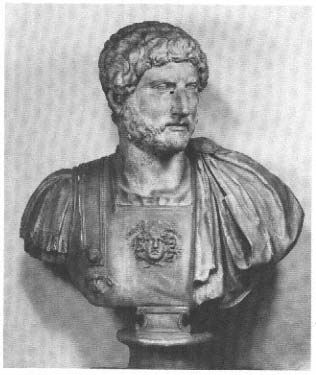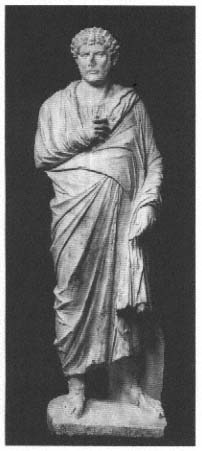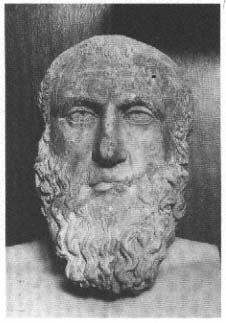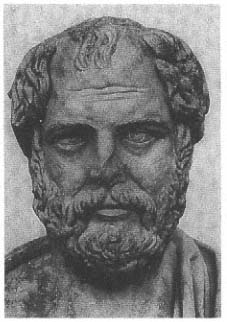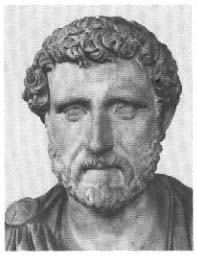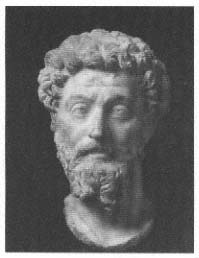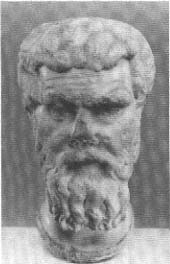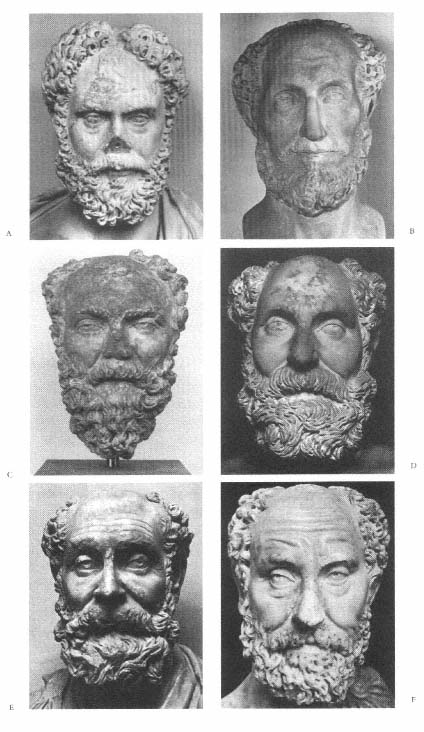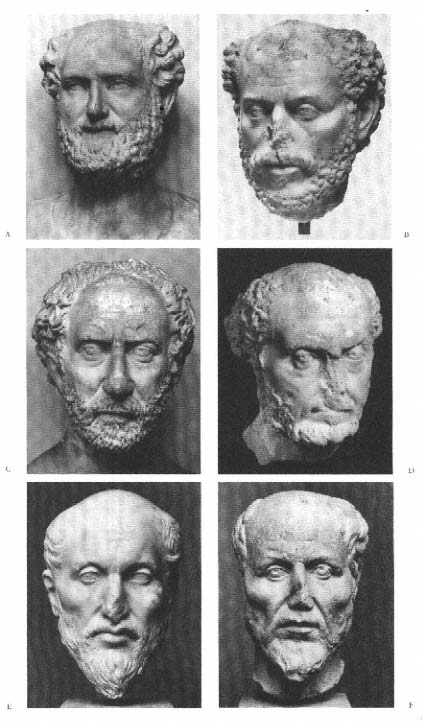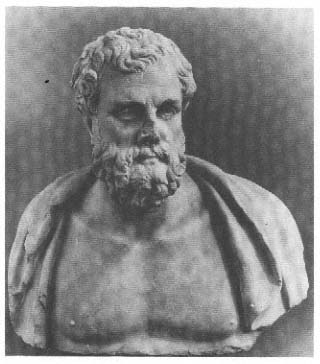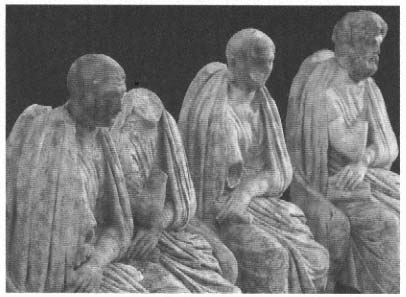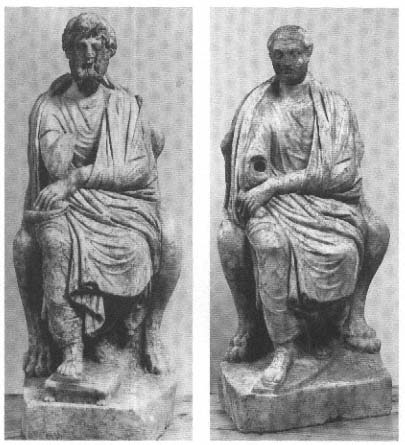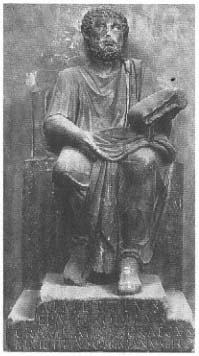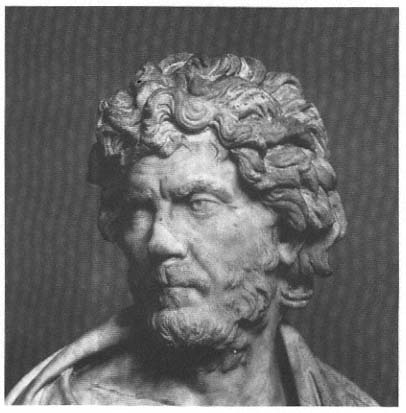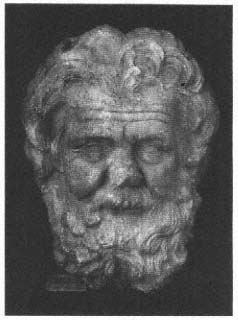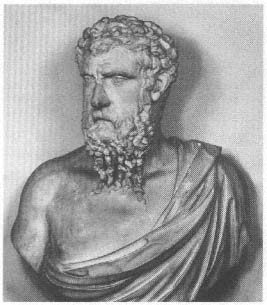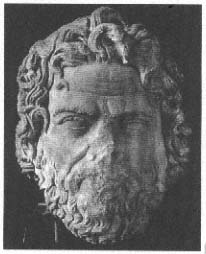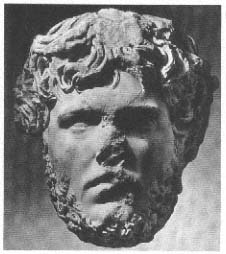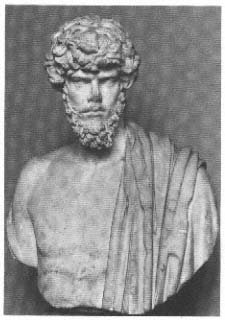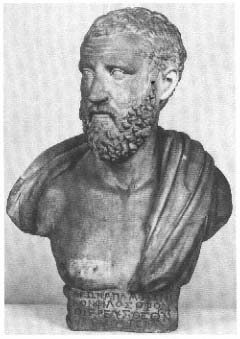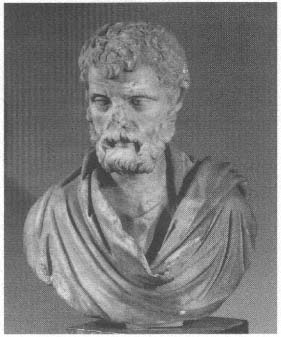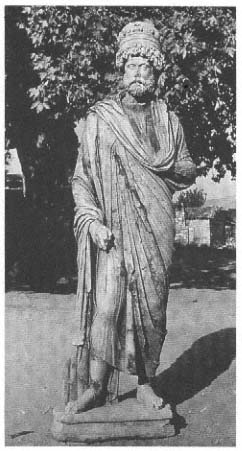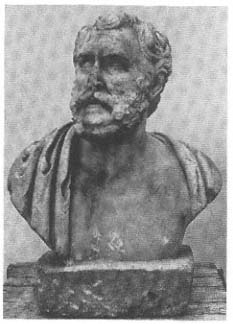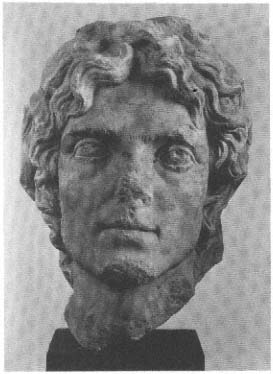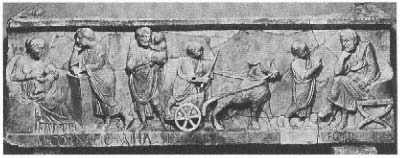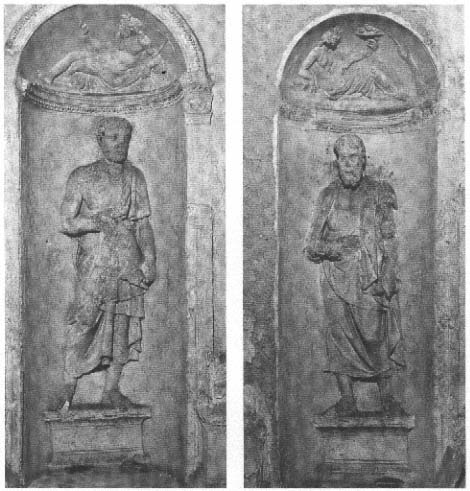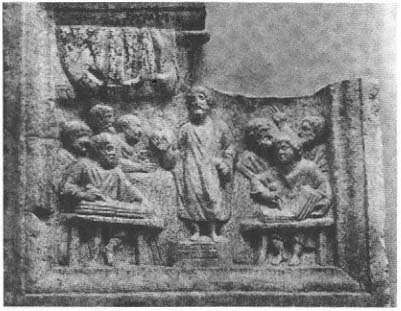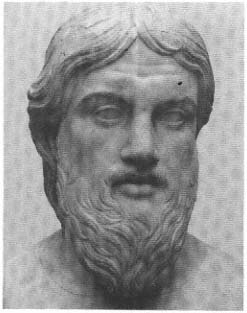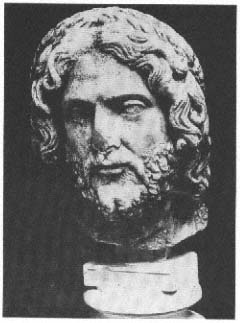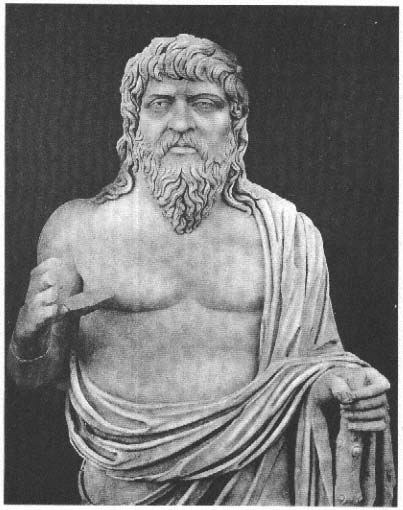V.
Hadrian's Beard
For myself, when I hear people speaking of the "ancients" [antiques], I take it that they are referring to persons remote from us, who lived long ago [veteres, olim nati]: I have in my mind's eye heroes like Ulysses and Nestor, whose epoch antedates our own times by about 1,300 years. You on the other hand bring forth Demosthenes and Hyperides, whose date is well authenticated. They flourished in the days of Philip and Alexander, and indeed survived both these princes. This makes it plain that between our era and that of Demosthenes there is an interval of not much more than 300 years: a period which may perhaps seem long if measured by the standard of our feeble frames, but which, if considered in relation to the process of the ages [saeculum] and the endless lapse of time [aevum], is altogether short and but as yesterday.
—Tacitus Dialogus 16 (trans. W. Peterson)
In Rome, the pursuit of intellectual activities was at first a strictly private matter, unlike the situation in the Hellenistic cities of the Greek world. For the Romans, these were the leisure pastimes of the élite, manifestations of otium confined to the home. They were kept separate, both spatially and temporally, from negotium, the sphere of political, legal, and social responsibilities that occupied the senator and patronus in Rome. The professional intellectual, who played such a conspicuous role in Greek society, had always been a rather marginal figure in Rome. The origins of this phenomenon are clear: from the third century B.C. , Greek teachers had come to Rome as slaves and entered the homes of the nobility. Later, many stayed on as in-house philosophers, poets, librarians, schoolteachers, and doctors, all dependent on the favor of a patronus or other paying customers, even though they might often enjoy a special position as amici . In their confronta-
tion with the Greeks, as is well known, the Romans had come to see themselves principally as statesmen and soldiers born to rule. They imagined all their chief virtues and ideals most perfectly embodied in the figure of the pious, fiercely decent, and courageous peasant farmer of ancient Rome. This paragon was created, of course, at a time when he no longer existed—if indeed he ever had.
It is not hard to see how in these circumstances the public acknowledgment of intellectual activities was rather problematical. The Roman attitude toward intellectual pursuits remained ambivalent well into the period of the Empire, fluctuating between passionate devotion in private and restraint, if not actual distrust, in public, for everything that concerned culture and learning was clearly the domain of the conquered Greeks.
Even though this ideological claim eventually became little more than a well-worn topos, a certain wariness remained.[1] Under these circumstances, it is obvious why no Roman of the upper class would have displayed his intellectual interests, much less ambitions, as part of his public image. It would never have occurred to a Cicero or a Seneca to appear in public dressed like a poet or philosopher or to have himself portrayed in a way that celebrated his intellectual abilities or pretensions. Rather, their portraits are realistic and present us with men whose faces radiate a sense of energy and concentration (figs. 106, 107). They wish to be seen as active statesmen, not as distracted thinkers racking their brains over theoretical problems.[2]
Likewise, the professional intellectuals, usually from a Greek-speaking and servile background and dependent on Roman patrons, tried to assimilate to the general citizen image and had themselves depicted in the toga of the Roman citizen, with appropriate hairstyle and facial expression—insofar as they ever received honorary statues in the first place or could afford their own funerary monument. The rare exceptions only confirm the rule.
The public image of the philosopher was molded largely by the filthy and lower-class itinerant Cynics. The Roman citizen had an ambivalent relationship with them, comparable to the popular attitude toward mendicant monks in the Middle Ages. They were, on the one hand, held in contempt because of their parasitic nature, their outra-
Fig. 106
Cicero (106–43). Augustan copy of a portrait made
in his lifetime. Rome, Capitoline Museum.
geous appearance, and their arrogance and pushiness. Yet, at the same time, they were admired for the way they adhered entirely without compromise to their "alternative life-style." Nevertheless, the distaste with which Seneca reacts to their moral insistence shows how irritating they could be, even to a socially assimilated Roman intellectual (Ep. 5.1–2). We shall see how a certain fascination for the man in the street later emanated from this image of otherness.[3] But for now Seneca's reaction to their vulgar appearance only confirms the general bias against Greek philosophers.
Fig. 107
Seneca (ca. 4–65). Small-scale double herm (with
Socrates) of the third century A.D. , after a portrait made
in Seneca's lifetime. Berlin, Staatliche Museen.
I do not mean to suggest, however, that no positive image of the intellectual existed at all. Rather, as we have already seen in chapter 1, the houses and villas of the rich often contained whole series of portraits of poets and thinkers. But these were almost exclusively images of celebrated Greeks of the distant past.[4] Copied from Classical and Hellenistic portrait statues, only reduced to busts, they shaped the Romans' image of the man of intellectual pursuits, as someone who enjoyed a position of great authority but belonged to a very different age. Their unfamiliar beards and hairstyles alone immediately separated them from the outward appearance of contemporary Romans. As we shall see, every subsequent attempt by the Romans to visualize their own intellectual strivings remained indebted to these icons of classical culture, not only in Rome itself but throughout the Empire.
The picture I have just sketched was not, however, an unchanging one. In the course of the first and second centuries A.D. , the funda-
mental values of Roman society underwent a profound transformation. With the advent of a monarchy. political concerns became gradually secondary, while culture and learning moved into the very center of the social discourse. (In the cities of the Greek East, this process had begun already in the Hellenistic period.) The introspective preoccupation with all forms of Greek culture—myth, art, literature, philosophy, as well as history and customs—gradually created its own dynamic and evolved into various kinds of intense devotion that are reminiscent of religious ritual. In the process the very identity of the Romans underwent a thoroughgoing change. The dichotomy of Greek and Roman tradition largely disappeared as "classical" culture became the common culture of the entire imperium Romanum .
In view of this I believe it is quite legitimate to speak of a "cult of learning." The object of this cult was the whole of classical culture. To Roman society it appeared in the form of a self-contained entity, an absolute and unquestioned religious dogma in which one could take part through particular cultural pastimes and from which one could derive a model for proper behavior and self-fulfillment. The rituals in the cult of learning consist essentially of various forms of commemoration and assimilation. The objective was to adapt the whole of society to the ideals and example of classical culture. In this process, each individual had to strive to become, as far as possible, a perfectly "classical" man. This meant not only "the care of the self," as Michel Foucault put it, a philosophical way of life embracing both body and soul, but also the shaping of the physical environment according to Greek models, including the outward appearance of the individual. Thus it is that in the course of the second century A.C. much of the male population took on a "classical face," or at least the beard of the learned man. It is Hadrian's beard that marks the turning point.
Because of the extraordinary "classicism" that permeated all of Roman culture under the Empire, this chapter and the next will be concerned less with the representation of particularly important individuals than with society's attitude toward intellectual activity and the implications of this for the way the Romans saw themselves and chose to have themselves portrayed. For more than three hundred years the intellectual layman will be the protagonist of our story, which begins
with the aristocracy of the Late Republic, who played at Greek culture in their great villas and surrounded themselves with galleries of portrait busts representing the famous Greeks of the past.
The World of Otium and the Gentleman Scholar
Portraits of well-known Greeks have been found almost exclusively in lavish villas and private houses. Very rarely were they set up in public buildings, even theatres, as had been the case in the Greek cities.[5] This is in keeping with the almost exclusively private nature of the Roman experience of Greek culture at the beginning, and with the peculiar separation of the two spheres, otium and negotium, that resulted from the dramatic process of acculturation of Roman society after the incorporation of the Greek city-states into the Empire. The feeling that the Roman senator could abandon himself to the pursuit of Greek culture only while on vacation, and preferably outside the city of Rome, was directly related to the senatorial aristocracy's concern for the preservation of its own traditions. Again and again it passed largely symbolic legislation, such as sumptuary laws, the banning of private cults of Dionysus, or the persecution of Greek intellectuals, in an attempt to define a Roman "national identity" in the face of the Hellenistic world. What passed for Roman traditions were of course recognized as such only in the process of defending them from any intrusions from the Hellenistic culture of the Greek cities.[6]
The reality was naturally often very different from what the ideology of the mores maiorum would lead one to expect. The great Roman families had long been "Hellenized," both in the conduct of their daily lives and in their interest in Greek literature and art. By the second half of the second century B.C. parts of Rome already looked like a Hellenistic city, and Rome was unquestionably one of the centers of the Hellenistic world. This transformation necessarily included an intellectual life played out in public, though within definite limits. Theatrical productions at the great festivals of the gods were copied from Greek models, and Greek rhetoricians and philosophers gave public lectures. The latter phenomenon must have gotten so out of hand after
the Third Macedonian War (171–168 B.C. ) that the Senate felt compelled to set an example by imposing a general ban on the itinerant Greek intellectuals. When. a few years later in 156 B.C. , the jeunesse dorée of Rome came to hear Carneades' lectures in droves, Cato saw to it that the philosophers beat a hasty, retreat from the city "so that such men go back to their own schools and debate with Greek boys, while the Roman youth turn their attention to their laws and their leaders" (Plut. Cat. mai. 22).
The Senate's conservatism and resistance to the public display of Greek luxuria continued for another hundred years after the first wave of Attic philosophers and was so strong that these same senators, in many respects already men of the Hellenistic world, had to construct their own private world in which they could unabashedly and without regard for public opinion in Rome act the part of Greeks, that is, of sophisticated men of the world. The large country estates of the nobility and of local aristocracies were transformed into islands of Greek culture, complete with smaller-scale and compact versions of the public cultural institutions of Hellenistic cities. This phenomenon is reflected not only in the architectural forms employed but in the vocabulary used to designate them. Thus particular residential areas of the villa might be given names like gymnasium, palaestra, and xystus, or, even more specifically academia, lyceum, and biblioteca, pinacoteca, or mouseion. The decoration of such rooms was intended as an invitation to the world of Greek culture. Against this stage set, which could include real Greek philosophers, teachers, scholars, or poets as part of the "props," were played out carefully contrived rituals of high culture that ranged from readings of ancient authors to literary and philosophical discourse, to creative literary endeavors. The need to inhabit fully this world of Greek paideia seems to have been so great that its devotees even dressed the part, exchanging their toga for the Greek himation and sandals (e.g., Cic. Rab. post. 26).[7] In this way, while still Romans, they assumed a secondary identity as cultivated Greeks, much as they might build a large Greek peristyle onto their Roman atrium-style houses, a phenomenon we encounter from the second century B.C.
In the Hellenistic world, most intellectual activity had been an in-
tegral part of the public life of the city, conducted in such places as the stoas in the agora, the gymnasia, and the bouleuterion. But the Roman aristocrat at first could experience the life of the intellectual only in an exclusive and private world of leisure removed from public space. It is particularly revealing, as well as appropriate, that all the forms of Greek culture being adopted in Rome were regularly lumped together under the heading luxuria, not only in sumptuary legislation, but in contemporary social criticism. The notion that arose out of this, of culture as an appealing but not strictly necessary embellishment of real life, is one that clearly to this day shapes the popular understanding of high culture.
At the beginning of the Brutus, Cicero invites his friends Atticus, then living privately in Athens, and Brutus, the future assassin of Julius Caesar, to gather at his villa and, seated on the lawn around a statue of Plato, to engage in learned conversation (Brut. 24). The three probably wore the Greek himation on such occasions. The scenario presents us with two images of the intellectual at once: the statue of Plato in the garden and the staged gathering of Cicero and his friends around it. Two centuries later the Platonic philosopher Nigrinus would receive his friend Lucian "with a book in his hand and surrounded by many busts of ancient philosophers standing in a circle" (Lucian Nigr. 2).
The portrait of Plato takes on particular significance in Cicero's villa, for we know that Cicero revered Plato above all others as the intellectual authority.[8] In Atticus' villa this position was occupied by Aristotle. Beside his portrait stood a bench that Cicero remembered fondly as the spot where the two men had philosophized together (Att. 4.10.1). For Brutus, whose passion was public speaking, it was Demosthenes, and he even set up a portrait "among his ancestors" (inter imagines: Cic. Orat. 110).
"One must acknowledge one's spiritual ancestors and honor them as gods. Why should I not possess the images of great men to inspire my mind and celebrate their birthdays? I worship them and model myself after these great names," remarked Seneca (Ep. 64.9–10). Brutus and Seneca are not isolated instances. "Spiritual ancestors" often
played the role of personal protectors and patrons. A number of bronze statuettes survive from the Early Empire, such as that of the reader (fig. 71), which stood in a domestic shrine of the Lares, as did Brutus' portrait of Demosthenes.[9] Lucian mentions a physician who particularly treasured a small bronze bust of Hippocrates (Philops. 21), and the fine bust of Hippocrates discussed earlier (fig. 83) was found in the grave of another physician in Ostia.[10] The many rings that were worn and used as seals, bearing portraits of Greek poets and philosophers, may also perhaps be seen as less demonstrative means of acknowledging a particular intellectual "patron saint" (Cic. Fin. 5.3; Pliny HN 35.2).[11]
Richard Neudecker has drawn a fundamental distinction between portraits of intellectuals that were objects of reverence or even cult worship and those that were purely decorative elements in the furnishing of a villa. In practice, however, there was probably considerable overlap between the two functions, since intellectual pursuits were not as a rule restricted to special rooms within the house. One might study and converse in a small room for relaxation (cubiculum ) or at meals, just as well as in the portico or garden. Thus portraits of famous Greeks could be found in all these places, in the widest variety of materials and sizes, from over-life-size statues to herms to little statuettes and busts in marble, bronze, silver, or plaster. There were also images painted on wood (often attested in libraries), in wall paintings, and in floor mosaics, as well as on drinking vessels and expensive furniture.
But the primary purpose of the portrait galleries of celebrated Greeks in Roman houses and villas was undoubtedly to conjure up an impression of learning. In the overly competitive climate of the Late Republic and Early Imperial period, cultural pretensions quickly became a vehicle for winning distinction. Soon Juvenal would complain that you could not go to the home of the most uneducated man without seeing plaster casts of the great philosophers and wise men (2.1–7). Trimalchio boasts of never having heard a single philosopher, even though he owned two libraries, one Greek and one Latin (Petron. Sat. 48.4), and Seneca complains that the uneducated nouveaux riches mis-use the most precious books as bits of decoration (Dial. 9.9.4).[12]
Particularly effective were the "galleries" of numerous herms,
Fig. 108
View of the Stanza dei Filosofi. Rome, Capitoline Museum.
which usually stood in a portico or the park, lining the paths or beside fountains. It is easy to picture the heads of great men lined up in long rows when we recall the eighteenth- and nineteenth-century galleries of busts in the Vatican or Capitoline Museum (fig. 108). As a rule, however, these rows of busts in the villa gardens did not embody any artfully conceived program, as we might be led to expect from modern experience. Rather, the same types are repeated countless times, in constantly changing but mostly random combinations. Representatives of the different philosophical schools could stand alongside one another as cordially as statesmen who had been mortal enemies in life.
Most villa owners will not have given a great deal of serious thought to the choice of decorative sculpture they bought (or had bought for them), or have paid much attention to it later on. Cicero's worrying about just the right selection for the gymnasium in his Tusculan villa is rather the exception.[13] The point was to evoke the leading lights of Hellenic history and culture in all their rich variety, though, interest-
ingly, the intellectuals account for at least three quarters of all the portraits found in Roman villas and thus must have largely determined their character. The man who purchased these statues and busts wanted in the first instance to show that he belonged to the educated class and therefore to the upper ranks of society.[14]
Yet there is more to this practice than just the element of display. The imagery of the Roman house is permeated by a fundamental need to recall to mind and conjure up earlier Greek culture. Indeed, the Roman villa of the Late Republic may be considered the origin of the cult of learning that would come to characterize the Principate. Like the many mythological scenes on walls, ceilings, and floors, the portraits of famous Greeks were meant to evoke in encyclopedic fashion all of classical Greek learning.
For the same reason, catch phrases or brief quotations attributed to the subject were sometimes carved on the shafts of herm portraits. The intellectual level of these texts is as a rule rather modest. So, for example, the herm of Bias carried a saying that may be authentic but is still not particularly edifying: "All men are evil." Other patrons, however, were more ambitious. Thus one portrait of Socrates has beneath it a quote from Plato's Crito, and a particularly zealous proprietor might have a brief biography of each subject added to the stone, or even a catalogue of a poet's works. Neudecker has been able to demonstrate that second-century A.C. galleries of herms were sometimes arranged in alphabetical order, marble encyclopedias of classical learning that the viewer could commit to memory as he strolled back and forth.[15]
All this is, of course, reminiscent of the decoration by the cultivated bourgeoisie of houses and other dwellings in the nineteenth century with countless heads of Laokoon, contorted with pain, and stately heads of Zeus on heavy oak furniture. But then, the presence of such cultural icons in the Roman house signified not only self-conscious pride in a hard-earned humanistic education and social standing, but also a kind of voluntary obligation on the part of the owner of such treasures, a reminder, amid the fashionable trends, of a commitment to a certain system of values.[16]
Fig. 109
Silver cup from a villa at Boscoreale. First century B.C. H: 10.4 cm. Paris, Louvre.
Amid the ubiquitous presence of so many serious portrait heads of long-dead Greeks, surely some comic relief was needed. Two silver cups were found in the treasury of the villa at Boscoreale depicting a whole series of well-known Greek poets and philosophers—only as skeletons (fig. 109).[17] No amount of wisdom can ward off death. Yet the skeletons of the great still continue their debate on the Boscoreale cups. Epicurus reaches greedily for a large cake that the proverbial pig beside him has also been sniffing. To telos hedone ("Pleasure is the highest goal") is inscribed above the cake. On the other side, the skeleton of Zeno, with hand upraised, argues passionately against this view. Other sayings written in Greek, as well as the pictures on the second
cup, all come down to the same basic message: Enjoy life while you can. Yet the image of the ancient poets and philosophers as skeletons also reminded the contemporary viewer of how Greek philosophers had long been made fun of because of their apparent preoccupation with death. If this seems banal, the iconography nevertheless implies a certain level of education and suggests that making fun of philosophers was a standard part of the cultivated banter at the symposium. The skeletons on the Boscoreale cups are not the only images of this type. The gluttony of ancient wise men was also a popular subject (cf. fig. 70). In the Terme del Sapienti in Ostia, the Seven Wise Men are shown magisterially giving instruction, including advice on digestion and bowel movement.[18]
In order to evaluate the role and significance of Greek intellectual portraiture within the context of the whole pictorial vocabulary of Roman Imperial art, we must bear in mind this ubiquity in every conceivable size and medium. Hardly a single Roman who lived in one of the larger cities could have failed to have these portraits firmly fixed in his mind. And this situation obtained equally in the Greek East of the Empire and in the Latin West, for the classicizing aspect of Roman civilization became one of the important cornerstones of the uniform culture that permeated the whole Empire.
Humble Poets and Rich Dilettantes
Against this background, two statues in the Vatican, which we considered earlier in discussing Hellenistic portrait statues of poets, take on an added significance as evidence of the Roman preoccupation with otium (fig. 110). As we have noted, sometime after the middle of the first century B.C. the heads of the Greek poets were reworked into portraits of contemporary Roman aristocrats.[19] That the patrons were indeed members of the senatorial aristocracy is revealed by their shoes. The indication of the calceii senatorii is indisputable proof of their social rank. Thus cultural pretensions and pride in one's social status go hand in hand. The provenance suggests they originally stood in the garden of a city residence on the Viminal Hill, that is, that they served to dis-
Fig. 110
Statue of the Hellenistic comic poet Poseidippus. The
portrait head was reworked into that of a Roman senator
after ca. 50 B.C. Cf. fig. 75. Rome, Vatican Museums.
play the patrons' cultivated image within the private sphere. The claims they make were directed at invited guests of comparable status. This case is typical of the whole phenomenon. Portraits of famous Greeks were so pervasive in their influence that by the first century B.C. the Romans could express their own intellectual aspirations only by allusion, assimilation, or by actual appropriation, as in this instance. Such statues blatantly transform the would-be intellectual's habit of affecting Greek dress, about which we have already heard, into a permanent image.[20]
It is no accident that these two Romans had themselves depicted
not as philosophers, but as poets. In the Roman imagination, the cultivation of Greek literature was desirable, but only as a means for perfecting one's skills in public speaking or one's style in the writing of history. The pursuit of philosophy especially when taken too seriously or for its own sake, remained suspect well into the High Empire—even though more than a few Roman aristocrats did indeed practice serious philosophy from the first century B.C. on. The writing of poetry, on the other hand, early on enjoyed recognition in society. Ennius was already frequenting the houses of the aristocracy, and Angustus would later accord public honors to his favorite patriotic poets. Yet the professional poets at Rome, even the greatest among them, were not autonomous and remained dependent on a patronus .[21]
This is all the more remarkable when we consider that literary dilettantism was virtually epidemic in Rome by the time of Augustus and involved the entire aristocracy, including the imperial family. (Nero's artistic career and public appearances performing his own compositions may be counted here as well.) In his Darstellungen aus der Sittengeschichte Roms of 1922, Ludwig Friedländer already recognized the cultural significance of this dilettantism and the cottage industries associated with it. He also pointed out the connection between the old aristocracy's loss of political influence and its new preoccupation with amateur versifying. This is not the place for a detailed account of the various forms taken by such literary games. Suffice it to say that the combination of a plethora of public and private poetry readings, performances of song and dance, poetry festivals and competitions instituted by Nero and Domitian, with the expansion of both public libraries and the book trade gradually created something of a "literary public." The dimensions and spread of this self-propelling literary juggernaut seem to have been tremendous. The volume of invitations that were not to be declined must have quickly become too great, even for someone like Pliny the Younger, who himself wrote and recited poetry.[22]
Along with the culture of otium, this passion for literature, beginning in the time of Augustus, represented another important step toward the "cult of learning." In both instances, one was transported through literary and other pastimes into a world of high culture far
Fig. 111
Portrait of a woman composing verse. Fresco from
Pompeii, ca. A.D. 50. Naples, Museo Nazionale.
removed from the reality of life. The poetry itself was predominantly on apolitical themes, cloaked in a veil of allegory and mythological allusion. The intellectual culture of otium spread out from the villas and to some extent took over public life as well. Not only recitations of poetry, but also theatrical performances and pantomime, seduced the audience into a world of myth. Juvenal ironically condemns the resulting loss of any sense of reality: "No one knows his own house as well as I know the grove of Mars, the cave of Vulcan, and the Aeolian rock" (1.7ff.).
These literary pastimes were not limited to the city of Rome, as one might suppose from the written record alone. I would argue that they are also reflected in the many small-scale wall paintings in the houses of Pompeii showing writing utensils along with readers and writers, images that have never been satisfactorily explained. On a well-known portrait tondo (fig. 111), a young woman with Claudian coiffure looks out at the viewer while pressing a stylus to her lip in a gesture of distracted contemplation. The little tablets in her hand also allude to her
interest in writing. This distinguished woman, adorned with earrings and a golden hair net, is surely not a writer by profession, nor would she need to demonstrate that she is able to write. Probably she is the mistress of the house, or one of the daughters, shown composing poetry. Another equally famous tondo depicts a young married couple. Once again the woman holds writing utensils, but her husband is also characterized as an educated man by the prominently displayed book roll. Similar portrait tondi have been found in several other Pompeian houses. Some of these show a youth with book roll and a laurel wreath in his hair, a reference perhaps to actual or anticipated victories in poetic competitions. The tondo form suggests that the bourgeoisie adopted this newly fashionable manner of having themselves portrayed from the public libraries, which we know displayed portraits of poets. It is also striking that those shown as poets are almost invariably women or youths. In the private world of otium, women were equally admired for their literary pursuits. It is unlikely that the citizens of the once Oscan city of Pompeii were any more passionate about learning than those of other Italian cities. Rather, these small pictures attest to an astonishingly pervasive enthusiasm for the reading and writing of poetry throughout the Italic world.[23]
The flowering of this extraordinary preoccupation with learning must have enhanced the self-esteem of the professional poet, even if his material circumstances, as the example of Martial indicates, had in fact worsened between the time of Augustus and the end of the first century. He remained dependent on the favor of a patron, compelled to celebrate his patron's villa or wife or taste in the fine arts.
A seated statue from Rome, now in the Albright Art Gallery in Buffalo, somewhat under life-size, presents a poet in a mood of remarkable, if rather strained, self-assurance (fig. 112). We recognize him as a poet by the book roll and Greek manner and clothing, a mantle that leaves the entire torso exposed. The models for this figure are not the earlier Greek statues of poets, in their citizen dress and relaxed pose, like Menander and Poseidippus, but rather the exaggerated heroic imagery of Late Hellenistic art that we saw exemplified in reliefs of Menander (fig. 74). The pose is here even more exalted. The poet sits straight as an arrow, with his legs apart, not unlike the type of Jupiter that inspired images of the enthroned emperor. The sculptor of a sec-
Fig. 112
Funerary statue of an Augustan poet,
from Rome. Buffalo, Albright Art Gallery.
ond statue of a poet in similar pose, Trajanic in date and now in the Terme, added the realistic features of advancing age to the bare torso, thus creating a link to the iconography of the philosopher. Both statues probably stood in grave precincts and represent professional poets. A member of the aristocracy could hardly have had himself so depicted, with none of the attributes of his social status. Furthermore, the statue in Buffalo was hollowed out inside, probably to contain the ashes of the deceased. It will most likely have stood in the funerary precinct of the patron, who may also have paid for this statue of his in-house poet.[24]
Whereas in these statues the use of allusion to Greek tradition to proclaim a particular virtue is somewhat heavy-handed, the parents of an aspiring and gifted poet who died in his youth, named Sulpicius
Fig. 113
Portrait of the boy poet Q. Sulpicius Maximus.
Detail from his funerary monument, ca. A.D. 94.
Rome, Palazzo dei Conservatori.
Maximus, had their son depicted as the proper Roman citizen, in a toga (fig. 113). He had competed against fifty-two Greek-speaking rivals in a poetry contest sponsored by the emperor Domitian. The proud and devastated parents spared no expense, including having the entire Greek poem that he recited inscribed on the gravestone. Interestingly, the poem portrays Zeus denouncing Helios for entrusting the chariot of the sun to the young Phaethon. It was too much for the poor boy, like Sulpicius Maximus himself, who died of exhaustion "because day and night he thought of nothing but the Muses."[25]
It seems as if the contemporary poet in the early Empire had a choice between only two radically different images with which he could identify: a seated statue in the Greek manner (but with the stan-
Fig. 114
Cuirassed bust of the emperor Hadrian. After A.D. 117. Rome,
Palazzo dei Conservatori.
dard Zeitgesicht derived from the current fashion of the imperial house) or the basic type of the Roman citizen.
Hadrian's Beard: Fashion and Mentalité
After the ultimate failure of Trajan's wars of conquest, the emperor Hadrian made cultural interests the focal point of his reign, and the Romans' new orientation in relation to Greek culture now found expression in the art of portraiture. At his accession to power in A.D. 117, the new emperor's official portraits presented him with artfully curled hair and a beard (fig. 114). The contrast with his straight-haired and
clean-shaven predecessor could hardly have been more striking.[26] The widespread amazement occasioned by the emperor's new fashion can be detected in the Historia Augusta, whose author claims that Hadrian wore a beard to cover facial warts (Hist. Aug., Spart. Hadr. 26). I would not rule out that such an imperfection did in fact impel Hadrian to let his beard grow. But this is hardly an explanation for the whole phenomenon, and especially its ramifications.
The Romans had been basically clean-shaven for centuries, although there had, of course, always been men who grew beards, especially soldiers. This is evident, for example, on the Column of Trajan. Yet in official portraiture, beards were generally avoided. This is probably in large part a reaction to the beards of the Greeks of old. To wear a beard was considered simply "un-Roman," even though Varro was aware that the ancient Romans had worn beards and that the first barbers came to Rome from Sicily about 300 B.C. (Rust. 2.11.10).
Hadrian's was not the long beard of the philosopher, to be sure, but it was full and carefully styled. He probably did not see himself as making a programmatic statement with his beard and hairstyle, and most likely he had worn the beard before becoming emperor. Wavy hair and a trimmed beard had emerged as a fashion under Domitian and later, under Trajan, became widespread, especially among younger men, as an alternative to the austere look of the emperor.
But by retaining the fashion as emperor, Hadrian consciously or unconsciously turned it into a "message." Inevitably it was adopted as the norm throughout the Empire by men both young and old. Since, however, the same emperor elevated philhellenism to the level of a political program, the beard's connotation of being Hellenized, or what I would call the "cultivated beard," was unavoidable. Unlike Trajan, Hadrian conspicuously surrounded himself with Greek intellectuals, dabbled in various learned pursuits, spoke a pure Attic dialect, and enjoyed appearing at both public and private occasions dressed in the Greek manner. Cyrene was surely not the only city that paid homage to him in this style (fig. 115). Furthermore, his philhellenism and dedication to the cause of high culture were regularly celebrated.[27]
I believe there are two principal phenomena that argue in favor of this often asserted, but occasionally questioned thesis, that the new
Fig. 115
Statue of the emperor Hadrian in Greek-style
citizen's dress (cf. fig. 26), from the Temple of
Apollo in Cyrene. London, British Museum.
fashion for beards did indeed connote learning and Greek culture once the emperor had set it in motion. First, in this same period, at first in Athens and soon in other cities of the Greek East, members of the ruling aristocracy began not only to grow beards, but also in many other ways—hairstyle, dress, manners—consciously to model them-
selves after the statues and portraits of well-known Greeks of the past. And second, as we shall presently observe, beards became steadily longer, until by the Late Antonine period they had reached the length of any self-respecting philosopher's beard.
The best examples of the self-styled classicism of the Greeks themselves are the portraits of kosmetai in Athens, which happen to survive in large numbers.[28] These were annually chosen magistrates who were responsible for the city gymnasia. They came from prominent Athenian families and usually held other civic offices later in life. They are therefore by no means professional intellectuals. Yet this new fashion among the Athenian aristocracy is only one of many manifestations of a movement toward an all-embracing cultural renewal, whose impetus was in turn an economic revival in the Greek cities and the growing influence of the Greek élite in the running of the Empire.[29] The ostentatious acknowledgment of their own cultural traditions, combined with what was at first a departure from the Empire-wide fashion emanating from Rome, suggests that a new kind of self-consciousness was suddenly coming to the fore. In this way the Greeks asserted that the era of their cultural greatness was not past but lived on. This reversion to being "true Greeks" could also sometimes carry an anti-Roman connotation, as Dio of Prusa attests when he describes with admiration the Greeks of Borysthenes, or Olbia on the Black Sea, who have faithfully maintained the customs of their ancestors: "They all wore long hair and flowing beards, according to the ancient custom, as Homer describes the Greeks. Only a single man was shaven, and he was despised and scorned by the rest. They said he did this not for his own enjoyment, but to flatter the Romans and to proclaim his sympathy for them" (36.17). In actual fact the beards of these Borysthenians were probably those of Scythian barbarians, but that is of no consequence. What is important is the nostalgic search for ancient Greece that colors Dio's view. Among the kosmetai, who proudly identify with their famous ancestors, some have long beards, some shorter; some bear a general resemblance to the Greeks of old, while others seem to follow a specific model. Thus one contemporary of Hadrian looks like a latter-day Plato (fig. 116; cf. fig. 38), though he has severely trimmed his hair in comparison with Plato's (we shall see presently why he did this).
Fig. 116
Athenian kosmetes assimilated to the likeness of
Plato. Ca. A.D. 140. Athens, National Museum.
Fig. 117
Athenian kosmetes . Second half of the second
century A.D. Athens, National Museum.
Socrates, Aeschylus, Theophrastus (fig. 117), and Demosthenes were all pressed into service as models. By the Antonine period, Antisthenes enjoyed a special popularity in Athens, which, as we shall see, also entailed the rigorous pursuit of a philosophical way of life. The same trend is evident in the nicknames and tags that became popular once again. Thus, for example, Arrian was celebrated as "the new Xenophon."[30]
Hadrian's new Hellenizing image is comparable to these Athenian "memorializing" portraits. His beard could be likened to those of such Late Classical portraits as Aeschines (fig. 26). When we consider that only six years before becoming emperor, Hadrian had held the office of archon in Athens, it is tempting to associate his beard with the classicizing fashion that was just taking hold there.[31] Perhaps the young
Fig. 118
Antoninus Pius (emperor 138–161).
Rome, Capitoline Museum.
Fig. 119
Marcus Aurelius. After A.D. 176. Frankfurt,
Liebieghaus Museum.
aristocrat had occasion during his stay in Athens to redefine what had been a beard connoting Roman luxiria into an Atticizing "cultivated beard."
Be that as it may, for our inquiry the most important question is, how did the public throughout the Empire react to Hadrian's new beard? First of all, we must make a distinction between the general spread of the new hair and beard style, on the one hand, and the assimilation to specific, earlier Greek portraits, as by the kosmetai, on the other. The fact that the emperor's beard was immediately imitated through the whole Empire, including the West, need not surprise us. The emperor and his family had long been the ultimate arbiters of popular style, their portraits the decisive inspiration for changes in fashion.[32] More important, however, in this case is the fact, as we have already noted, that in the course of the next two generations, beards became steadily longer, until by the late second century they reached the length of the extremely full philosopher's beard. The portrait of Hadrian (fig. 114) and the three later heads juxtaposed here (figs. 118–
Fig. 120
Portrait of the emperor Pertinax (A.D.
193). Leiden, Rijksmuseum.
20) will illustrate this process. Trends in fashion are always in some way a reflection of collective values, and there is good evidence that the lengthening beard over a period of more than two generations is tied directly to a widespread cult of learning in the Antonine age.
When an entire society, or at least those groups that shape its character, devote all their spiritual and intellectual energies to recreating a classical culture, when this is the standard for all approved entertainment, and the participants, dressed as Greeks, play "Classical Greece" on the public stage (we shall hear more about this later), then we can hardly escape the conclusion that these steadily lengthening beards must carry a reference to classical learning. This is not to say that each individual made such a personal commitment, as in the case of the kosmetai . Rather, this is a fashion that becomes an integral part of the social discourse. The individual who wears a beard need not even be aware of his role in all this.
The portraits of the kosmetai and that of Hadrian belong to the early
stages of this process of the ever-growing beard. In its latest phase, starting roughly with the later portraits of Marcus Aurelius (ca. 175; fig. 119), we find a whole series of distinguished bearded men, including the emperor Pertinax (fig. 120), with deeply furrowed brow and raised eyebrows.[33] In this context such traits can hardly mean anything other than introspection and an intellectual bent. Another element of the fashionable "Intellectual look" is the receding hairline or bald head, suddenly popular in the later second and early third centuries. Prior to this, baldness had been very rarely shown, though it can hardly have been any less common in real life. If in the Late Antonine period it first was thought worthy of representation, then it was probably because the evocation of Classical portraits of intellectuals conferred on these individuals a mark of spiritual distinction. Support for this interpretation can best be found in the Praise of Baldness (Phalakras enkomion ) of Synesius of Cyrene (370–413), who refers specifically to the portraits of such "ancient wise men" as Socrates and Diogenes in order to prove that the wisest men had been bald. Socrates, he claims, had identified with the silen's mask "to mark his skull as the seat of wisdom" (nou docheion ).[34]
Often baldness and the thinker's brow are combined in the same head and mutually reinforce one another (figs. 121, 122). One former athlete even had himself depicted in this manner, in a portrait whose intellectual forehead, with brows drawn up and tensed furrows, is especially pronounced (fig. 122c).[35] A well-known portrait type of Severan date with a highly spiritual effect, once identified as Plotinus by H. P. L'Orange, may also be mentioned in this context (fig. 122f).[36]
The plethora of examples over a relatively short span of time suggests that we are dealing here with the phenomenon of the Zeitgesicht, analogous to the assimilation of civilian portraits in fashion and physiognomy to the reigning emperor. But in this case it is not Imperial portraiture that set the trend, but the reverse. There are individual
Fig. 121 a–f
Portraits of the Late Antonine and Severan periods in the guise of
intellectuals. Sources: see p. 178 n. 35.
replicas of the official portraiture of Marcus Aurelius and Pertinax that are assimilated to this popular Zeitgesicht of the intellectual.
Even more clearly than the general phenomenon of the ever-lengthening beard, this Zeitgesicht reflects a widespread consensus, at least among that class that commissioned marble portraits, on the central importance of all aspects of education and learning. Of course in some instances wrinkles or baldness could simply be a realistic rendering of an individual's appearance, and some scholars have rightly detected a stylistic tendency toward realism in Late Antonine art. This is not, however, at odds with what I like to call the "intellectual Zeitgesicht, " since what matters most is always which elements are realistically rendered.
There can be no doubt, however, about the meaning of what I would call the "learned busts": portrait busts wearing only the Greek himation and often leaving most of the chest bare. (These become popular in the same period when the beard is becoming longer). They are quite different from the completely nude busts of athletes and must rather be understood as a kind of abbreviated form of the Classical Greek draped statue, or perhaps of the ascetic Hellenistic philosopher type. It is difficult to decide from the busts alone whether a particular example is meant to celebrate the subject more generally for his classical learning or for specific philosophical pursuits. This is a question to which we shall return. These "learned busts" were equally popular in both East and West.[37] Their numbers and geographical distribution alone prove that a Greek education had become a crucial element in the self-definition and public image of the kind of men who could afford such a bust, in all parts of the Empire. To be sure, the Roman citizen bust or statue type in toga, the bust wearing cuirass or paludamentum, both embodying the ideal of virtus, have not been entirely replaced by the "learned bust," but at least we can say that this new symbol now takes its place among the others as a perfectly respectable alternative.
Fig. 122 a–f
Portraits of the Late Antonine and Severan periods in the guise of
intellectuals. Sources: see p. 178 n. 35.
Fig. 123
Bust of a Roman citizen in the guise of a philosopher. Antonine
period. Thessaloniki, Archaeological Museum.
In those instances where a portrait head showing the features of the Classical intellectual is combined with a bust draped in the Greek himation, as is the case, for example, with two splendid Greek busts in Thessaloniki (fig. 123) and Budapest, as well as a whole series of others from Rome and the Western and Eastern provinces, most archaeologists have not hesitated to identify the subjects as professional philosophers or rhetoricians.[38] But the considerable number of these busts alone makes this unlikely. Rather, as with the kosmetai, we are probably dealing here with members of the urban élite who wished to advertise their classical education but, unlike the kosmetai, not necessarily with reference to a specific model.
In certain cases, especially among examples from Greece itself, the physiognomy is assimilated so closely to that of a famous Greek figure of the past that the subject's individuality is all but lost. This phenomenon should not overly disturb us, for other Romans had for some time adapted their own faces to that of the reigning emperor. Now, however, there is another authority, alongside the imperial family, as a role model after which to pattern oneself and one's image. In the Greek East, the effects of this can also be read in funerary and honorific inscriptions. The epithet philosophos is widely used and may even take precedence over the more expected philokaisar and philopatris .[39]
Nevertheless, I wish to emphasize that not every full beard signifies a passionate intellectual, nor was there any shortage of competing styles and values expressed in portraiture of the very period when the Antonine beard was at its height, and especially the period that followed. We need only think of the lush curly locks of a Lucius Verus, who was said to have sprinkled gold dust in his hair (Hist. Aug., Capitol. Verus 10.7), or of the crew cuts of the soldier-emperors. But amid this rivalry of symbolic statements, and perhaps because of it, the intellectual image remained for quite some time an influential standard in both East and West.
It was quite possible, for example, to combine the portrait type of the third-century soldier-emperor, projecting toughness and energy, with a bust clad in the philosopher's mantle or even a full statue in the pose of a classical philosopher. Such combinations indeed occur in two of four statues found recently in a wealthy house at Dion, adopting the pose of the seated Epicurus (figs. 124, 125).[40] The other two statues had portrait heads with long beards (in one instance only partially preserved) of the Late Antonine/Severan "intellectual" type. It is entirely possible that the group does not represent philosophers and their pupils, but rather a family of the Greek aristocracy who were devotees of philosophy and learning and wanted to show off their cultivated way of life in an ostentatious family portrait gallery. The older generation still wears the "philosopher's beard" fashionable in the Late Antonine period (fig. 125a), while the younger adopts the Zeitgesicht based on the portrait types of Caracalla and subsequent emperors (fig. 125b). The fact that all four had themselves shown in the pose of Epicurus
Fig. 124
Statue group from a wealthy residence in Dion (Macedonia). Several period.
Dion, Museum.
could imply that they wanted to acknowledge themselves as followers of Epicurean philosophy, but need not. As we shall see, the iconography of Hellenistic philosopher portraits was rather eclectically used, not always adhering strictly to the original connotations. The pose of the Epicurus statue was probably favored because it gives the appearance of the upstanding citizen with one arm enveloped and the mantle properly draped. This would appeal especially to would-be intellectuals of the bourgeoisie in the Greek East, where Classical drapery styles were still being worn.[41] If this proposition is correct, then we must consider whether other supposed philosopher statues of the same period, such as the so-called Aelius Aristides in the Vatican Library, might not also rather represent an intellectual layman. One could easily imagine a statue like this in the context of a portrait gallery in which the honorand was depicted in a variety of costumes, each projecting different virtues (cf. p. 279).[42]
Fig. 125 a–b
Two seated statues from the group in Dion. Dion, Museum.
Superficially, we are dealing here with the same phenomenon as the two reworked statues of poets in the Vatican of ca. 50 B.C. (cf. fig. 110): a Greek body type taken over to stand for the idea of intellectual activity. But now it is not a phenomenon limited to an aristocratic and exclusive culture of otium, conferring the notion of Greek learning on an élite stratum in the Late Republic. Rather, learning is now a gen-
erally recognized ideal in Rome itself, one that is publicly acknowledged and leads to the acquisition of high status and even political office.
As we would expect, under these conditions professional intellectuals of all types traded in their toga for a Greek himation as the public insigne of their career. At least this was true in the West; in the East, such differentiation was not possible, since everyone wore the himation. In Carthage around the year A.D. 210, if we may believe the testimony of Tertullian, "simple elementary schoolteachers, teachers of figures, grammar, rhetoric, and dialectics, as well as doctors, poets, musicians, astrologers, augurs, in short, everyone who cares about scholarly pursuits, wears the Greek mantle" (De pallio 6). It was probably the new position of authority now accorded the leading orators and philosophers more than anything else that in the Late Antonine age induced ordinary teachers and doctors to identify with their image. A fine example from Rome itself is the under-life-size statue of the grammaticus graecus M. Mettius Epaphroditus, a freedman in Rome whose former slave Germanus set up the statue, most likely as a funerary monument. Epaphroditus sits on a raised teacher's chair, though he is not actually shown giving instruction, like the elementary schoolteacher on the famous relief in Trier. He holds in his left hand a book roll, in which he has been reading (or perhaps reading aloud), and now contemplates what he has just read, turning his head to the side and looking up (fig. 126).[43] The fact that Germanus had his patronus shown in this meditative pose suggests that he wanted to commemorate him not simply as a teacher, but as a man who cultivated a philosophical way of life.
Tertullian's inclusion of doctors in this group can also be corroborated by the archaeological evidence. A well-known strigilated sarcophagus of the late third or early fourth century, now in New York, shows a physician from Ostia. He, too, is a reader, sitting at home next to a cabinet in which we can make out more book rolls and a dish (perhaps for opening veins), and, above, a set of surgical instruments, propped up so that we can see them better. In other words, the wisdom and learning of the ancients are more important to this individual than
Fig. 126
Funerary, statue of the grammaticus
Graecus M. Mettius Epaphroditus.
Severan period. Rome, Palazzo Altieri.
the tools of his trade.[44] Under the Early Empire, in contrast, physicians and teachers had modeled themselves on the general image of the Roman citizen, clad in the toga and wearing a hairstyle derived from that of Imperial portraiture.[45]
Apuleius and the Case of the Uncombed Hair
When the writer Apuleius, who came from Madaura in North Africa, married a wealthy widow about A.D. 160, her family, fearing the loss of their inheritance, ensnared him in a lawsuit on charges of magic that
could have had serious consequences.[46] He was also accused, among other things, of passing himself off as a philosopher under false pretences. As evidence they cited his handsome and carefully tended appearance, describing him, ironically, as philosophus formosus . Instead of philosophy, they claimed, he was really practicing the magical arts, that is, he had bewitched the widow. Thus if a man wanted to be acknowledged publicly as a philosopher, at least according to Apuleius' accusers and the people of Sabratha, where the trial took place, the one thing he could not appear was handsome. Apuleius at first responded with a learned defense, in which he cited examples of handsome Greek philosophers, including Pythagoras, but then continued:
And yet this sort of defense does not suit a man of my humble appearance. The constant strain of study has drained all the charms of my body, bent my posture, dried out my vital juices, turned my face pale, and crippled my powers. And as for my hair, which these brazen liars claim to be worthy of a seducer: just look at it, and see how elegant and seductive it is! Twisted and tangled, stiff like straw, stringy, clotted in little lumps, it has been untended for so long that it could never be disentangled, let alone combed or parted.
(Apol. 4.1)
Undoubtedly this is how Apuleius appeared in court, otherwise his eloquent defense would have seemed ludicrous. The learned proconsul Claudius Maximus was won over and declared him not guilty. Yet his accusers were probably not the "shameless liars" he claimed them to be. For as a celebrated rhetorician, priest in the imperial cult, and suitor for the hand of the widow, he cannot have appeared in public with unwashed hair all the time. The citizens of Carthage celebrated him, in the inscription beneath his honorific statue, as philosophus platonicus,[47] and such a comparison had always conjured up a well-tended appearance (cf. p. 240). We can conclude only that Apuleius deliberately played a variety of roles, depending on the exigencies of a particular situation. And this is probably true of other famous intellectuals of the second century as well, who moved, as J. Hahn put it, "in that shadowy zone between philosophy and the Sophists."
The case of Apuleius shows that there was a certain pressure on the professional intellectual who was also a public figure to define his own image, that is, to declare himself as either rhetorician/Sophist or philosopher. When a well-known figure officially made the transition from one profession to the other, this might even be staged as a kind of public ritual. For example, when one Aristokles, a Pergamene aristocrat, gave up his affiliation with the Peripatos and became a rhetorician and pupil of Herodes Atticus, he also renounced his earlier disregard for his own appearance, with uncombed hair and filthy clothes (these had evidently become generally recognized symbols of the philosophical way of life, irrespective of which school one belonged to), and took on not only a soigné image but also the appropriate friends. From now on he would cultivate a life of luxury and pleasure, replete with music, theatre, and banquets (Philostr. VS 2.3.567). And when Peregrinus Proteus did the reverse, taking the "vows" of a strict philosophical life and, like a medieval saint, giving away his inheritance to the city of Parion, this was done in the form of a public spectacle, at which the people cheered his conversion, shouting: "Yea, thou art truly a philosopher, truly a patriot, a true follower of Diogenes and Krates" (Lucian Peregr. 15).[48]
These efforts at self-definition, and others like them, were "classical revivals," as it were, replaying the old debate between Isocrates and Plato on what should take precedence in the education of the young. But the insistence upon a fundamental distinction between the two ways of life cannot have been mirrored in the actual practices of daily life, which was marked rather by continual compromise. Indicative of this is the way that Philostratus speaks of "the philosophical oratory" of the ancient Sophists (VS 1.480).
It is against this background, I believe, that a whole series of unusual portraits becomes intelligible. A well-known bust in Vienna has long been taken to be that of a barbarian, on account of the unkempt, almost ravaged appearance (fig. 127).[49] In fact, the head could be an illustration of Apuleius' masquerade in court. The long, coarse, and irregularly trimmed hair is presented as a hopelessly tangled mass of thickly matted strands against which no comb would stand a chance. The short beard grows irregularly and is as wild and unkempt as the
Fig. 127
Bust of a man in the guise of a serious philosopher. Ca. A.D. 160.
Vienna, Kunsthistorisches Museum.
hair. In addition, ugly traits like the scar and a wandering eye are emphasized. The lower part of the bust, with its Greek himation, which is not modern restoration, confirms that this individual is indeed a man who wishes to proclaim his adherence to a rigorous philosophical way of life. An earlier, Hadrianic head of an old man is no less unkempt and likewise lays claim to the life-style of a Cynic philosopher, since his wild hair is a virtual quotation from portraits like that of Antisthenes (fig. 128).[50]
Fig. 128
Portrait of an Athenian characterized as
a "new Antisthenes." Antonine
period. Athens, National Museum.
Both these heads come from Athens, the mecca of the cult of learning in the Imperial period, as also do the portraits of the kosmetai, which remain the most impressive examples of the revival of the "ancient Greek" image. But even in Rome itself there were men who valued an image of strict philosophical observance. Thus, for example, a portrait in the Capitoline Museum presents a haggard old man with ill-tempered expression, his hair matted in little clumps and a long "Pythagorean" beard that would defy any comb (fig. 129).[51]
Such extreme instances are, to be sure, not very numerous. Interestingly, the types most commonly met are compromises, uniting varied iconographical elements into an eclectic combination. Evidently the majority of men who prized the philosophical image also wanted to appear at the same time cosmopolitan and thus combined features
Fig. 129
Bust of a philosopher, or of a Roman
citizen leading a strict philosophical life. Rome,
Capitoline Museum.
of philosophical seriousness with those of a bourgeois urbanity. In another portrait from Athens, for example—this one found on the Acropolis—the stylization of the hair across the forehead is clearly an allusion to Antisthenes, the original Cynic, while the beard and facial expression, in contrast, look carefully tended, and even the hair relaxes into gentle locks as it moves toward the sides (fig. 130).[52] The figure from the Dion group discussed earlier, with the long beard and the Epicurean body, has a hairstyle that is rather in the tradition of Antisthenes and, strictly speaking, does not suit at all the proper bourgeois pose of the statue of Epicurus (fig. 125a).
Once we have become attuned to this phenomenon, it becomes clear that there exists a whole series of heads with noticeably unkempt hair, for which we must consider the possibility that the subject in-
Fig. 130
"New Antisthenes" from the Acropolis.
Antonine period. Athens, Acropolis Museum.
Fig. 131
Portrait of an anonymous contemporary of
Lucius Verus, ca. A.D. 160. Rome, Terme Museum.
tended in this way to call attention to his ascetic way of life. The most striking examples come once again from Athens, but quite a few have been found in the West as well.[53] The story of Apuleius' day in court confirms that this trait was indeed generally understood as a symbol of asceticism. An even earlier example of this phenomenon may be seen in the splendid Hadrianic shoulder bust from Rome, now in Copenhagen (fig. 132).[54] The carving of the locks of hair is a tour de force, but the mass of thick clumps could be meant to look matted and uncombed, especially since the young man has had himself depicted with no undergarment and with a skeptical, almost glowering look. Likewise, the subject of a well-known head in the Terme Museum in Rome (fig. 131), once erroneously taken to be a portrait of Lucius
Fig. 132
Bust of a dandy with philosophical
pretensions. Hadrianic period. Copenhagen,
Ny Carlsberg Glyptotek.
Verus, might have used the same means to project a philosophical image.[55] For the modern viewer it is of course not always easy (particularly with the state of preservation of some heads) to distinguish between an artfully arranged wig and naturally wild hair.
Yet the case of Apuleius makes it clear that defining oneself as an ascetic no longer entailed an identification with a particular philosophical school. Apuleius, after all, who boasted in court of his Cynic's unkempt hair, was regarded as a Platonist, while Theon of Smyrna, a contemporary of Hadrian, who is likewise designated as platonikos philosophos on a bust from Smyrna now in the Capitoline Museum (fig. 133), has a well-tended appearance with the close-cropped hair that traditionally marked the Stoic (cf p. 111).[56] He, too, apparently
Fig. 133
Bust of the Platonic philosopher Theon. Hadrianic
period. Rome, Capitoline Museum.
wished to be considered a "moderate" ascetic. This would also explain why the contemporary kosmetes in Athens who is otherwise so reminiscent of Plato wears his hair cut very short (fig. 116).
We do not know where most of these busts were originally displayed and whether the majority of them represent a professional philosopher or a "layman." But the large number of busts bearing a "philosophical" look in itself suggests that most are laymen. The original viewer probably could not distinguish either, in the absence of an inscription or knowledge of the individual. But the visual evidence tends to confirm the argument that in this period philosophy was less concerned with the clear definition of specific schools of thought than with promoting a spiritually oriented attitude and way of life.[57] These
portraits, then, stand in sharp contrast to the original portraits of the great philosophers of the third century B.C. , which had drawn clear distinctions among the various life-styles and philosophical orientations. The contemporary philosopher Demonax, who was so revered by Lucian (or perhaps invented by him), explicitly admits to a kind of eclecticism in the matter of academic teachings and sees the philosophical way of life as the true essence of all philosophical thought (Lucian Demon .). Asceticism, the renunciation of luxury, and continual mental exercise had become the basic components of philosophy in all the different schools. Neglect of one's outward appearance was the visible symbol of this way of life and proclaimed a commitment to a form of self-fulfillment based on strict moral principles. Thus when an otherwise elegant gentleman like the Platonist Theon had his hair cut short, this was probably a none-too-subtle indication that he wanted to be taken more seriously.
Those individuals who had themselves portrayed with unkempt hair and glowering mien may on occasion actually have appeared in public this way, like Apuleius in court. This would in turn imply that projecting such an image did not necessarily do any harm to a man's reputation among his social equals and the community at large. Self-control was now the mark of a man of distinction and justified his social status. A regimen of daily mental exercise was indispensable. The emperor Marcus Aurelius is one among many who aimed to put into practice a philosophical way of life. His Meditations were meant to instill self-control and to be a reminder of the philosophical principles that should govern our lives. These exercises were not practiced alone, but as part of an interchange with like-minded individuals under the guidance of an instructor.
They were in turn complemented by the practice of a physical asceticism, as in the regimen of the monastery, though we learn little of this in our sources. But we may presume that Marcus Aurelius was just one of many who slept on the floor as a token of his ascetic nature and to set an example for others (Hist. Aug., M. Ant. 2.6–7). Restraint in both eating and sexual activity reflect a concern for body as well as spirit. The same attention was devoted to both maintaining a certain diet and controlling the digestion.
The Elegant Intellectual
The leading orators of the day were the exact opposite of the philosophers in their public image. They wore extravagant clothing, reeked of precious scent, and expended enormous effort on the care of both hair and body. Alexander of Seleucia, for example, whom some considered the son of Apollonius of Tyana, possessed a beauty that was like a "divine epiphany" (if we may believe Philostratus). The Athenians were intoxicated "by the splendor of his large eyes, the lush locks of his beard, the perfect line of his nose, his white teeth, and long slender fingers," even before he opened his mouth to speak (VA 2.5.570–71). And yet their contemporaries also attacked the Sophists, whose luxurious ways they so admired, for their greed. This, too, of course, is a classicizing topos. The public appearances of these superstars who elicited such admiration were by no means limited to speech making. Polemon of Laodicea in Asia Minor (ca. A.D. 88–144), one of the most brilliant "concert speakers" of his day, traveled with "a long train of pack animals, many horses, slaves and dogs of various breeds for different types of hunting. But he himself traveled in a Phrygian or Celtic wagon with silver trappings" (Philostr. VS 25.533). His own arrogance was a match for his appearance.
We would expect to find portraits of such men marked by a striking elegance and fashionable touches. Yet unlike the images of ascetic philosophers, those of the elegant Sophists cannot with certainty be identified among the plethora of preserved portraiture of the Antonine and Severan periods. If we take the portrait of Herodes Atticus as our standard (fig. 134), it is not all that different from those of other kosmetai derived from Late Classical models.[58] The same is true of the portrait of a rhetorician and benefactor of the city of Ephesus in Severan times whose identity is unfortunately unknown to us. The portrait stood in the imperial hall of the gymnasium of Vedius and reveals itself as that of an orator through its Aeschines-like pose.[59]
But this is not really so surprising, since these Classical faces sufficed to express the intellectual pretensions of the orator. In addition, they can hardly have wanted their public portraits to fuel even more the charges of luxuria constantly being made against them. On the con-
Fig. 134
Bust of the rhetorician and statesman Herodes
Atticus (ca. 101–177). Paris, Louvre.
trary, we may suppose that most of them wished to combine their man-of-the-world elegance with a hint of philosophical seriousness, though not going as far as to give an impression of the severity of the Cynics or the toughness of the Stoics.
Apart from Herodes Atticus there are, unfortunately, no securely identified portraits of the celebrity orators. Yet a statue like that of L. Antonius Claudius Dometinus Diogenes, the patron and "lawgiver" of Aphrodisias, "father and grandfather of Roman senators," may give some idea of the splendid public image of such men. (fig. 135).[60] As a sign of his priestly office he wears a diadem adorned with portraits of the city goddess and the imperial family. The case with many book rolls alludes to his learning, while the epithet Diogenes expresses his genuine commitment to the philosophical life. This has not stopped
Fig. 135
Portrait statue of Lucius Antonius Claudius
Dometinus Diogenes, from the "Odeon" at Aphrodisias.
Early third century A.D. Aphrodisias, Museum.
him, however, from sporting an elaborate coiffure that could hold its own against that of a Lucius Verus.
Other portraits of this period, such as those of two magistrates from Smyrna, now in Brussels, are remarkable for their elegantly styled beards and yet wear their hair closely trimmed, like Theon the Plato-
Fig. 136
Bust of the great orator Polemon (ca. 90–145),
Athens, National Museum.
nist. In his case, we took this Stoic trait as a subtle suggestion of a philosophical seriousness.[61] Anton Hekler made the attractive, but entirely hypothetical, suggestion that a bust found in the Olympieion at Athens represents the above-mentioned Polemon of Laodicea (fig. 136). It was he who, in A.D. 131 in the presence of the emperor Hadrian, delivered the dedication speech for the Olympieion. He spoke passionately and, in the Asiatic baroque tradition of oratory, did not shy away from such dramatic effects as leaping up from his throne. The portrait's dramatic turn of the head and the mannered gaze, unique in the portraiture of the Roman Empire, would well suit such an occasion, particularly since it is reported of Polemon that throughout the speech he kept his gaze fixed on a single spot.[62]
The search for a specific portrait type for the Sophists seems to lead
to a dead end. For the time being, at least, we cannot detect one with certainty among the preserved material. And yet the examples we have just considered show that, alongside the portraits of amateur intellectuals with Classical faces and the unkempt hair of the true ascetic, there were others with an elegantly soigné appearance steeped in luxury. It seems unlikely in these instances that the bare chest under a philosopher's mantle should be taken literally, with its original connotation of the toughening of the body through physical deprivation, as in the statues of Chrysippus and other Hellenistic philosophers. As we have seen, busts of this type are quite common starting in the Hadrianic period. Rather, this feature has probably become simply a formula signifying Greek-style paideia .
The Past in the Present: Rituals of Remembrance
To summarize thus far, we have seen how the upper echelons of society were steadily taking on a new cultivated look. Whether they did this simply by the unthinking adoption of a newly fashionable beard and Zeitgesicht or consciously modeled themselves on specific prototypes, whether they looked this way in real life or only in their portraits, there can be no doubt that a man's image in society was defined using stereotypes from the onetime iconography of the intellectual. (The fact that such stereotypes functioned as such only subsequent to their creation made no difference.) The beard is the basic standard by which we can measure the progress of this process of transformation. The phenomenon had its origins in Athens, and it was there and in other cities of the Greek East that this masquerade went to the greatest extremes. But in the West too, in the course of the Antonine period, contemporary faces are gradually assimilated to those of the ubiquitous busts of an earlier age. How are we to understand this phenomenon? Or rather, is there really a phenomenon here at all?
First of all, I cannot stress enough that this was not simply a phenomenon of the visual arts but shaped the real world of daily life as well. The wearing of a beard and the cultivation of an intellectual image were by no means restricted to élite circles, a rarified social game
like playing at being shepherds in the age of the rococo. For the Romans, the setting was the public arena. As I have noted, there is no doubt but that the portraits and their costumes to some extent reflect the public identity and appearance of the subject. (Whether this reverence for high culture extended to walking the streets half-naked in midwinter as an exercise in asceticism one may well question.)
Nevertheless, we must understand the "learned beard" worn by so many men within its larger context. It is but one of many facets of the collective striving to evoke in the present the cultural achievements of the past. The notion of a "Renaissance" often used of this period carries the wrong connotations. It was not a matter of trying to bring back to life something long dead, but rather of claiming that this glorious past was not really past at all but lived on in the present. To support this claim, a whole series of cultural activities served to conjure up the past, and a broad cross section of society took part, some more actively than others. The scenario can be best observed in Athens and elsewhere in Greece.
Fittschen has recently called attention to a group of portraits of youths and young men, mostly found in Greece, which, with their long flowing hair and heroic or elegiac expressions, often make a distinctly romantic impression (fig. 137).[63] Usually the portrait is combined with a nude bust, intended to recall Classical statues of heroes and athletes, as opposed to the "intellectual bust" partially draped in the himation. Fittschen has detected in this fashion an assimilation to Alexander the Great, and, indeed, some of the hairstyles are quite close to those of Alexander's portraits. But in the case of a number of these young men, who occasionally wear a short beard as well, identifying the source of the hairstyle in the portraiture of Alexander does not give the full story. For the contemporary viewer, the range of associations of these portraits must have been much broader. The variety of hairstyles worn by young men starting with Antinoos is particularly striking. I believe the long hair represents rather a general reference to the Classical image of the young hero. This does not, of course, rule out a specific reference in some instances to Alexander, whose own portraits are in turn closely linked to images of Achilles. Many ancient authors, from Homer on down, speak of Achilles' blond hair and the beautiful
Fig. 137
Portrait of a young Athenian in the guise of
the epic heroes. Antonine period. Athens,
National Museum.
long locks of other heroes. "From his head she made the thick locks descend like hyacinth," says Homer of Odysseus, when Athena has transformed him into a dazzling youth after his landing on the island of the Phaeacians (Od. 6.230). This and other comparable passages are cited by Dio of Prusa in his Encomium of Hair . Synesius of Cyrene found Dio's treatise so charming that he quoted parts of it in his own Praise of Baldness . Contemporary Roman viewers who were not so steeped in the poetic tradition would nevertheless have understood the connotations of long hair, thanks to the many mythological scenes in wall painting and on floor mosaics and carved sarcophagi.
And the romantic hero was not to be found only in the visual arts. At Marathon Herodes Atticus encountered a real-life Herakles, whom he invited home (he did not, however, accept). Herodes went hunting with his "sons" Achilles, Memnon, and Polydeukion. After their early deaths, he honored them like heroes, with funerary games and banquets, and erected stelai, herms, and altars to them on his vast estates. The Heroic Age of myth should carry on right into the present.[64] The story of Herodes is not a unique instance of the evocation of the mythical past, only unusual in its dimensions. Only recently there appeared on the art market a magnificent bust, probably from Greece, representing a young man as a new Diomedes.[65]
Women's fashions also started to look back at times more or less directly to Classical models, to judge from surviving statues and sculpture in relief. On the hundreds of preserved Attic gravestones of the Early Empire and later, the women are almost exclusively depicted in one of two Late Classical statue types, known in archaeological parlance as the "grande Herculanèse" and the "petite Herculanèse." It is hard to imagine that actual clothing, especially what was worn on festival days, could have looked very different. The men on the gravestones and in honorific statuary are also portrayed in a Classical costume that goes back to the fourth century. At least in the matter of clothing, the past truly did live on in the present. This phenomenon is not limited to Athens. Wherever in the Empire substantial numbers of honorary female statues have been found, they inevitably belong to one of a very few Classical or Hellenistic types. There are, of course, variations in individual preference, but the basic dependence on a relatively small number of models drawn from earlier Greek art remains unchanged through the first two centuries of our era.
The intellectual image was thus only one of several "costumes" that contemporary individuals could put on in order to turn themselves into "ancient Greeks" and, in so doing, demonstrate the unbroken continuity of classical culture.[66] In Athens and other Greek cities of long standing, at least the actors in this masquerade, these latter-day Sophists, heroes, philosophers, and romantic youths, had a genuinely ancient stage setting on which to appear. In many instances these
places now received a major face-lift: we need only think of Hadrian's great building program in Athens and especially of the Olympieion, after so many centuries and so many patrons now finally completed thanks to the emperor. These monuments of the past were real enough and encouraged people to believe that they were not simply living in a dream world.
Along with the costumes and the stage sets came a variety of retrospective rituals. We have already noted, in discussing the literary dilettantes and the public and private poetry readings of the Early Empire, how in general nonpolitical activities and neutral forms of exclusive social intercourse steadily grew under the Principate. By the time of Nero and the Flavians, it is clear that education and intellectual pursuits have become an important measure of social prominence. From the time of Hadrian, poetry is gradually displaced by such prose genres as learned rhetoric, along with philosophy. The curious phenomenon of the Second Sophistic, some of whose elements may be off-putting to us today—the fixation on themes from the distant past, the rhetoricians' spectacular feats of memory, the pedantic straining to achieve the purest Attic dialect with the most arcane expressions—all this can be understood only within the context of an entire society struggling to revive the memories of the past. The formal speeches held at the great city festivals and Panhellenic games are also part of these rituals of remembrance, elements of an all-encompassing discourse in both the public and private spheres that provided the Romans with a communal assurance of the continuity and living presence of the past.
No less than in public, the private sphere and various forms of daily social interaction were characterized by the backward-looking rituals of the cult of learning. Perhaps the most revealing of these is the practice of learned conversation at the symposium. The handy compendia of classical culture contained in the Attic Nights of Aulus Gellius and the fifteen volumes of Athenaeus' Deipnosophistai, and even earlier in the nine books of Plutarch's Conversations at Table (Quaestiones conviviales ), offer a wide spectrum of useful knowledge of all kinds, organized thematically: mythical and historical, literary and philological, scientific and philosophical, antiquarian, abstruse, and fantastic. From these
works we gain an authentic (and also idealized) picture of the topics, views, and arguments that were likely to come up in learned conversation after a meal. As in the rhetorical showpieces delivered in public, here too in these evening conversations a good memory and mental alertness were all-important. But the strenuous effort required was mitigated by the fact that no one expected originality. Rather, intellectual prowess could be demonstrated time and again by calling up the same topics, the same exempla drawn from myth and history. As odd as this sounds to us, it is not so long ago that it was still common practice in Europe to prepare in advance for a dinner party. In some places the topics of conversation planned for the evening were indicated on the invitation so that one could prepare with the help of such conversation manuals as Isaac d'Israeli's Curiosities .[67] At the ancient dinner table, whatever the subject, whether hetairai or philosophers, culinary delicacies or the intricacies of prose style, the examples cited always came from the distant past, the paradigms from the world of myth, and any advice or precedent was centuries old. In short, this was an age of, as it were, living classicism, which shaped much of both art and life.
The most celebrated intellectuals were competing for more than just public recognition. Glen Bowersock has shown how they often came to rank among the leading citizens of their respective cities and led the political and cultural rivalry with other cities, as well as competing among themselves for the favor of the emperor, who would award them higher and higher public office.[68] The emperors themselves even fell under the sway of this cult of the intellect and its high priests. The leading Sophists became their closest advisers and friends, oversaw the Greek bureaucracy, and educated the imperial children. The emperors were not just observers and patrons of this cult but took an active part in it, whether it be the romanticized pederasty of Hadrian or the introverted meditations and philosophical exercises of Marcus Aurelius, composed in Greek.
While for the élite education and intellectual prowess were an avenue to success in the competition for status and influence, for broad strata of the prosperous bourgeoisie these inevitably became tokens of social acceptability. The numbers of those actively involved in the general craze for learned pursuits, like the amateur poets, seem to have
Fig. 138
Sarcophagus of the youth Marcus Cornelius, with scenes from
his childhood, from Ostia. Ca. A.D. 150. Paris, Louvre.
rapidly increased. This is seen most impressively in the mythological imagery so popular on sarcophagi starting in the time of Hadrian. The Classical imagery employed becomes a form of dazzling and recherché funerary rhetoric, mourning the deceased and celebrating his or her virtues by means of sometimes rather abstruse allegories and mythological parallels.[69] These learned images become much more than mere ornament and directly involve both patron and viewer, since the scenes echo their own situation (e.g., as mourners) or delineate a set of shared ideals. In this way even private experience was expressed through learned parallels, and the ordinary viewer felt drawn into the discourse of high culture as an active participant.
Nor was the daily life of the bourgeoisie unaffected by this phenomenon. On a child's sarcophagus of about A.D. 150, the life of a boy who died young is portrayed (fig. 138).[70] We glimpse the interior of a bourgeois household, with the mother herself quieting an infant. The father, standing nearby, also partakes of the shared familial bliss, but in a curiously distanced and intellectualized manner. He stands in the pose of the Muse Polyhymnia, leaning against a pillar and lost in meditation, a book roll in his hand testifying to his intellectual interests: a professor in the playroom!
On the other side of the scene he personally instructs his now adolescent son. This is a marked departure from both the conventional iconography and the actual circumstances of the age, at least in more
prosperous families. Later sarcophagi with such scenes of reading invariably feature a Greek teacher in this role. While the father here wears a toga, the professional tutors are depicted wearing only a himation over a bare torso, to indicate their strict adherence to the philosophical life. Yet this father is otherwise shown like a philosopher, in his contemplative pose.
The way he holds the child in his arm, again wearing a proper toga, is also without parallel. It would seem that in this instance the patron had a direct influence in determining the imagery and that he wanted to project simultaneously a cultivated life-style and the ancient ideal of the Roman paterfamilias, like the elder Cato. It was said that Cato liked to watch as his wife quieted their small son and, "later on, himself instructed the boy in reading and writing, even though his slave Chilon was an accomplished teacher of grammar" (Plut. Cat. Mai. 20.4). At the same time, the patron of our sarcophagus could have been influenced by a contemporary Stoic philosopher from the school of Favorinus, who insisted that even a woman of distinction should cradle her own child, since this was the way of nature (Gell. 12.1). This modest sarcophagus shows how intellectual pretensions were by now almost taken for granted among the middle class, and how they were entirely compatible with a sense of nostalgia for the proud traditions of Rome's past.[71]
The claim to universal learning is made much more spectacularly in the richly decorated funerary chamber of the freedman C. Valerius Hermia in the cemetery underneath St. Peter's. On the principal wall of the chamber stand five stuccoed statues in relief, the three in the middle representing patron deities of the family, including Hermes for prosperity (as well as being Hermia's "namesake") and Athena for education. To either side of these three, however, stand figures of intellectuals (fig. 139). Since both figures bear different portrait features, and the patron himself is shown with his family on the left-hand wall, it seems likely that these are the teachers of the deceased who are so honored. The upwardly mobile former slave evidently shared the ideals of his emperor, Marcus Aurelius, and was as grateful to his teachers as Marcus, who set up their golden imagines alongside the Lares in his domestic shrine (Hist. Aug. , M. Aurelius 3.5). The two intellectuals
Fig. 139
Philosopher and rhetorician, probably the teachers of Gaius Valerius. Stucco reliefs
from the tomb of the Valerii in the necropolis under St. Peter's. Ca A.D. 170.
on Hermia's monument. it should be noted, are clearly distinguished from one another in manner and appearance. The elder, on the right-hand side, is easily recognized as a philosopher by his long and unkempt hair. The other is most likely the teacher of rhetoric, judging by his carefully draped garment and elegant coiffure.[72]
When a freedman like Hermia honors an ascetic philosopher as his mentor, then we are justified in thinking that the general attitude in Rome toward philosophy has decidedly changed for the better since the days of Trimalchio. To be sure, people's expectations of philosophy had also radically changed. No more contentious debates, abstruse definitions, or scientifically argued theses—in short, all the things the Romans had earlier made fun of. Instead, philosophy was now called on, first and foremost, as a guide to living one's life.
This had, of course, always been the role of the house philosopher. When Livia lost her son Drusus, she asked for philosophum viri sui (Sen. Dial. 6.4). This casual comment shows that philosophy's role as consolation was already well established at this time. Subsequently, however, people turned to philosophy not only for learned conversation or in moments of great need, but as a fundamental guide to life.
It was their growing "care of the self" that brought people under the Empire to philosophy and to the philosophers (as well as to mystery religions and others promising salvation). Neither the state religion nor the imperial cult could offer anything here, but a strict mental and physical regimen might. Physician and philosopher joined forces, for both taught the principles and standards of behavior, and both counseled their "patients" with advice, admonitions, and chastisement. The onetime scholar and learned partner in conversation became during the Empire a spiritual counselor, to whom people entrusted their well-being. As a result, the authority of the philosopher gradually increased once again, but it was now of a very different kind.
The Long Hair of the Charismatics
Let us return to the age of Nero and the Flavian emperors, for it is in this period that we hear for the first time of a new breed of philoso-
pher, who is celebrated not only for his towering wisdom, but for his extraordinary spiritual powers. Unlike the itinerant Cynics, these men came from wealthy and distinguished families, and, as opposed to the house philosophers, they taught publicly and gained access to the most exclusive circles of society. They had a special aura about them, as if elevated above the rest. Pliny the Younger, in A.D. 97, describes with great admiration one of these wise men, named Euphrates, who came from a prominent Syrian family. As a young man Pliny had established a close relationship of mutual trust with him, and after the death of Domitian, Euphrates taught publicly in Rome.[73] He is described as follows:
As far as I am qualified to determine, Euphrates is possessed of so many shining talents, that he cannot fail to strike and engage even the somewhat illiterate. He reasons with much force, penetration, and elegance, and frequently embodies all the sublime and luxuriant eloquence of Plato. His outward appearance is agreeable to all the rest: he has a tall figure, a comely aspect, long hair, and a large white beard: circumstances which though they may probably be thought trifling and accidental, contribute however to gain him much reverence [plurimum venerationis ]. There is no uncouthness in his manner, which is grave, but not austere; and his approach commands respect without creating awe. Distinguished as he is by the sanctity of his life [sanctitas summa ], he is no less so by his polite and affable address. He points his eloquence against the vices, not the persons of mankind, and without chastising reclaims the wanderer. His exhortations so captivate your attention, that you hang as it were upon his lips; and even after the heart is convinced, the ear still wishes to listen to the harmonious reasoner.
(Ep. 1.105–7, trans. W. Melmoth)
As we saw earlier, in the previous generation Seneca had warned the upper-class Roman who took an interest in philosophy in no uncertain terms not to affect the outward appearance of a philosopher, even if this had become his principal occupation, as was the case with Seneca himself after he withdrew from court. Even Euphrates claims that he had long tried to conceal his pursuit of philosophy from the
outside world (Epictet. Diss. 4.8.17). Yet in the course of the Flavian era, the philosopher must have taken on a new authority, culminating in the image of the Charismatic that Euphrates so impressively embodies.
Euphrates had studied with the Stoic philosopher Musonius Rufus (ca. A.D. 30–108), as did many others who later became famous as professional philosophers, including Dio of Prusa, Epictetus, Timokrates, and Athenodotus.[74] Musonius Rufus came from a family of equites in Volsinii and achieved great success teaching publicly at Rome. To judge from what is known of him, his philosophy was strictly in the pragmatic tradition, his main concern for leading a thoroughly correct and decent life, and to this end he offered specific instructions in proper behavior. When one reads his Diatribes, recorded in Greek by another hand, it is difficult to understand just why he enjoyed such tremendous authority. The same is true of Demetrius the Cynic, who was so admired by Seneca and other members of the aristocracy for his honesty and candor and his ascetic way of life.[75] The impact of these men, as of Euphrates, must have derived above all from their personal charisma.
With the advent of monarchy, the old Roman aristocracy lost its power, and many a senator will have found little satisfaction in attending the meetings of that body. In the search for a new orientation in life, they too turned in upon themselves. Philosophers like Musonius Rufus or Demetrius helped them, not only to come to terms with themselves, but to understand their political role under the Principate in a new way. As the importance of their pupils grew, so too did the status of the teachers. As had happened once before, in the Early Hellenistic age, this meant that philosophers inevitably came into intimate contact with those in power. There were close associations between the circles around Musonius and Demetrius. Both numbered among their members leading senators, including the heads of the so-called Stoic opposition. Demetrius supported the most famous of these, Thrasea, Paetus, when Nero forced him to commit suicide (Tac. Ann. 16.33–35), and another, Rubellius Plautus, was accompanied by Musonius into exile. These political confrontations between, on the one side, philosophically minded senators and their teachers and, on the
other, the emperors Nero and, later, Vespasian and Domitian had nothing to do with "Republican" inclinations, but rather with the determination to sustain a philosophical stance. This entailed, among other things, taking seriously one's duties as a senator and voicing one's views, even when this might have serious consequences for life and limb. The emperors were right in thinking that the roots of senatorial opposition lay with the philosophers. With sensational cases of exile, followed by recall and rehabilitation likewise ordered by the emperor, the prestige of this new breed of wise men rapidly grew, for the persecution enabled them to give proof of steadfast adherence to their own principles. Two senators, Thrasea and Seneca, had ended their lives by staging a kind of "Socratic" suicide, and the murder of Helvidius Priscus turned him into a philosophical martyr (Epictet. Diss. 4.1.123; Suet. Vesp. 15). This too was a new image of the intellectual, but one that did not find visual expression until Rubens's dying Seneca.[76] Musonius and Demetrius were exiled to barren islands, and Dio, driven out of his native city of Prusa, wandered over the countries of the East like a Cynic, giving philosophical sermons in many cities. Surviving these kinds of exile only strengthened the philosophers' personal conviction, as well as the public recognition they enjoyed.[77]
The persecutions ended with the death of Domitian in A.D. 96, and for intellectuals it was the dawning of a Golden Age. They became the friends and political advisers of emperors, pillars of the Principate. Dio spoke before the emperor Trajan on monarchy and rode with him in his triumphal car. Such was the respect that the emperor accorded him—and even claimed, in the good old Roman tradition, that he understood not a word of what the philosopher was saying. Hadrian befriended such well-known philosophers as Epictetus and Heliodorus and was said to attract grammaticos, rhetores, musicos, geometras, pictores, and astrologos (Hist. Aug. , Spart. Hadr. 16.10). Sophists and philosophers alike struggled to provide a theoretical justification of monarchy and, in so doing, drew upon the whole battery of classical argumentation.
It is remarkable how the philosophers of this period talk about their clothing, hair, and beards as never before, probably because, in a society in which the visual image played such a dominant role, they too
needed recognizable symbols to establish their identity and to reaffirm the considerable authority they had recently acquired. In one extreme instance, the Stoic Epictetus (ca. A.D. 55–135) claimed he would sooner let his head be cut off than his beard, so essential was the beard to his very identity (Diss. 1.2.28). His fears may not have been without some justification: Domitian had ordered the beard and long hair of Apollonius of Tyana, who later achieved such fame, to be removed (Philostr. VA 7.34).
But their role as public figures necessitated for the Charismatics more than a beard. They needed an entire image that would bring out their extraordinary characteristics, and the traditional image of the philosopher was evidently insufficient to the task. The strict differentiation among philosophical schools was no longer relevant to their new role, and a genuinely unwashed Cynic was not acceptable in civilized society. Euphrates and others of his ilk were strictly correct in their dress, interestingly, and in every respect clearly distanced themselves from the Cynics. They had to do this, given the ambivalent reputation of the itinerant philosophers and the lack of respect that they suffered (cf. p. 199). Euphrates' hieratic appearance and the stately manner of his instruction are dramatically different from the traditional, originally Hellenistic image of the philosopher engaged in discourse. Most of all, his public appearances were crowned with an aura of veneratio and summa sanctitas .
A small relief of the late second century in Ostia may give us some idea of the lecture style of these Charismatics (fig. 140).[78] While two scribes in the foreground try to capture every precious word, we can make out other captivated listeners behind them. The speaker stands on a podium, elevated above his audience. A curtain hints at a building that, like a portico or basilica, could be subdivided into individual rooms through the use of such curtains. Since the speaker wears only the tunica and not a toga, the scene cannot be set in the law courts. Rather, his upturned gaze and the solemn gestures suggest a philosopher.
But it was not just the general appearance of these new philosophers that was different, but also their faces. Euphrates' expression was "deep and serious" but not "dark" (Pliny has in mind here the faces of the
Fig. 140
Grave relief of a Charismatic philosopher (?) delivering a lecture.
Ostia, Museum.
Cynics). The face of the Charismatic radiates a transcendent goodness; he is not tortured by mental strain, for he knows the path and the conditions that will lead to a well-ordered spiritual existence. The external appearance provides the guarantee of his internal, spiritual superiority. That superiority, however, is not derived above all from an extraordinary intellectual capacity, as was the case with the great thinkers of the third century B.C. , but from the nature of his very being. We encounter in him for the first time the theios aner, or holy man, a figure who will take on much greater significance in the years to come. Pliny himself refers to the sanctitas of his friend Euphrates.[79]
What Pliny finds most impressive about Euphrates is his noble countenance, the long white beard, and the "beautiful" hair (clearly washed and combed) flowing to his shoulders. Long hair, along with the beard, is constantly remarked upon in connection with Dio of
Prusa and the other Charismatics of the second century, such as Aelius Aristides and Peregrinus Proteus. Unfortunately, in most cases we cannot tell from the context if the long "beautiful" hair of a Euphrates is meant, or the long unkempt hair of the Cynic, as Dio seems to have worn it on his wanderings.[80]
The Pythagoreans also served as a model for Charismatics like Euphrates, or, rather, they too affected a similar image, like the "holy" Arignotus (hieros daimonios ), who is made fun of in the pages of Lucian, with his long hair and "solemn face" (Philops. 29.32). Alciphron describes a gathering of philosophers at which the pale Pythagorean wears "long locks falling from the crown of the head to his chest and a very long and pointed beard" (see p. 110). In Philostratus' account, Apollonius of Tyana identifies himself, in manner and way of life, as a disciple of Pythagoras and refers to his long flowing hair as well as his garment of "pure linen" (VA 1.32).[81] Pythagoras was in addition known to have been a particularly handsome man (cf p. 234). A century after the time of Euphrates, we find in Philostratus a justification for shoulder-length hair in rather dramatic terms: "Let the head of a wise man be spared the clippers, for it is not fit that the iron should touch the place that is the source of all the mental processes and intuitions, whence all principles issue and the words that are the interpreters of his wisdom" (VA 8.7).
Philostratus' aversion to the shears is no doubt tied up with a belief in the magical powers of unshorn hair, which is common to a great many otherwise very different cultures. Rulers have worn their hair long as well as prophets, and the giant Samson was robbed of his powers when Delilah cut his hair. Among Classical and Hellenistic portraits of intellectuals, however, it is extremely rare to find shoulder-length hair, and then mainly on Homer. It is not entirely clear in these instances just what it means.[82]
Certain priests also wore their hair long (Dio 35.11). In their portraiture, they can be recognized by the wreaths or fillets on their heads. A particularly fine example is the Antonine portrait of a priest with myrtle wreath, from Apollonia in Cyrenaica (fig. 142).[83] Notice how the hair is distinctively parted in the middle, an iconographical feature that will later become a standard part of the visual imagery of Christ.
Fig. 141
Portrait of a philosopher. Second century A.D. (?).
Copenhagen, Ny Carlsberg Glyptotek.
If we take figures like Euphrates or Dio as forerunners or early examples of the theios aner, whose wisdom far transcends book learning and who claims access to deeper sources of insight into the human and divine, then the link to the iconography of the priest would only further strengthen the connotation of the holy.
That the charismatic effect of these "holy men" did indeed depend largely on their physical appearance is well illustrated by the case of Alexander Abonuteichos, the false priest of Asklepios. Only on his deathbed was it revealed that his long hair was not natural, but that the whole time he had been wearing a wig (Lucian Alex. 3; 13). Yet the wig had worked as well as if it had been his own hair. At least the oracular cult he founded survived this revelation and went on for several more generations.[84]
Fig. 142
Lost portrait of a priest, from Apollonia.
Second half of the second century A.D.
This new image of the philosopher with shoulder-length hair is unfortunately very seldom attested in the art of the High Empire. Since, however, it will play a key role in the iconography of both the Late Antique philosopher and of the bearded figure of Christ, I should like at least to mention a few dubious instances. Chief among these is a group of several marble portraits with long hair whose authenticity has sometimes been questioned, including heads in Copenhagen (fig. 141) and Munich. In my view both of these are works of the early second century A.D. that have subsequently been heavily restored and reworked. Looking ahead to Late Antique portraits of Christ and the philosophers, it is interesting to note that in several of these heads the hair parted in the middle accentuates the high forehead.[85]
A nearly fully preserved statue of an itinerant philosopher that came to light during excavations of the Agora of Gortyn on Crete can be dated to the Late Antonine period (fig. 143).[86] The usual identifica-
Fig. 143
Statue of a philosopher, from Gortyn. Antonine period. Herakleion, Museum.
tion has been based on comparisons with a coin portrait of Heraclitus with which, however, it has little in common. I would like to see it instead as the portrait of a Charismatic philosopher in the manner of Apollonius of Tyana. The raised right hand clearly marks the philosopher as a teacher. In his left hand he holds a staff in the form of a club,
which must contain a clue to his identity. The club was considered an attribute of the Cynics, for two reasons: first, because it recalled Herakles, the patron of the "sect," whose strength and endurance during his lifetime of roaming the world offered a paradigm for their own moral struggle; and second, because in their own itinerant lives they made good use of a club and sometimes needed it to save their skin.[87] Yet no one would want to identify the figure from Gortyn as a typical Cynic. He wears handsome sandals, and his smooth (i.e., clean) himation is carefully draped about the body in the Classical manner. Furthermore, the bundle of book rolls hints at his great learning. The absence of another garment under the mantle bespeaks the ascetic lifestyle of the itinerant philosopher, while the portrait type, with the carefully styled shoulder-length hair, recalls the image of Euphrates. This feature, along with the club, supports the identification as a theios aner, since many of these new Charismatic philosophers spent part of their lives as itinerants, whether willingly or in exile.[88]
We shall see in the final chapter how the image of the bearded Christ with long hair ultimately goes back to that of these "holy men." It is probably no accident that the visual record for the second century is so spotty, for the theios aner had at first no clearly defined place in society, or among the well-established forms of self-representation. If honorific or votive statues were ever set up for such men, these will have been single statues in bronze, unlike the many copies of Greek portraits, and will have long since been melted down.
